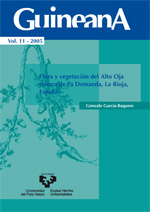Flora and Vegetation of the High Oja Valley (La Demanda Mountain Range, La Rioja, Spain)
##plugins.themes.bootstrap3.article.main##
##plugins.themes.bootstrap3.article.sidebar##
Abstract
In this study, the taxa of vascular plants have been catalogued; this work is also an attempt to describe the types of vegetal communities and the sucession and zonation processes of the High Oja Valley, a mountainous area covering 250 Km2 in La Demanda Mountain Range, located in the Iberian Mountain System, inside the Iberian Peninsula. The maximal elevation is found at Mt. San Lorenzo, an elevation of 2.270 m.a.s.l., and the minimal (710 m.a.s.l.), on a village called Santurde de Rioja. The Oja river, in its course toward the Ebro Basin, crosses an area in which can be distinguished two geomorphological units: the paleozoic southern nucleus, and the mesozoic northern border, which is partially covered by tertiary sediments; this border is located between the above mentioned nucleus and the Ebro Basin. The macrobioclimate belongs to the oceanic temperate submediterranean type. Three thermotypes and two ombrotypes have been distinguished in this work: suprasub-, orosub- and criorosubmediterranean for the former and humid and hiperhumid for the latter. The High Oja Valley is part of the so-called Sorian-Oroiberian biogeographic sector. The flora was sampled by using a design based on a previous teselar analysis. A floristic catalogue was elaborated; the areas of distribution and the life forms were studied. More than one thousand species and subspecies were identified; this number represents approximately forty percent of the flora existing in the region of La Rioja; this richness is more than it would be expected, given the size of the area. In this region we have found European (specially Atlantic) and Mediterranean (particularly occidental high-mountain) taxa. Also, some Alpine taxa and several other broad area species. Finally, an important pool of endemic Iberian taxa (basically high-mountain silicate-loving Iberian species and carbonate-loving Cantabrian-Pyrenean species) have been found in this area.
The sampling of the vegetal communities and the data analysis were done using the Braun-Blanquet approximation; in some cases, the partial classification hypothesis were tested by using multivariate statistical analysis techniques. More than seventy types of vegetal communities (association level or lower), belonging to thirty two classes of vegetation, were found. The lower timberline zone is basically colonized by European-Atlantic types of vegetation (broad-leaved forests, bushes dominated by species belonging to the Rosaceae and Leguminosae families, heathlands, grasslands and grazing lands), but there is no lack of some types of Mediterranean vegetation (ever green oaks, thyme and perennial basophilous xerophytic grass communities). In the upper timberline zones there are some typically occidental Mediterranean high-mountain types of vegetation (juniper communities and high mountain climactical swards), and also some Eurosiberian high mountain types.The sucession process was studied according to the Rivas-Martínez approach. As a result, were obtained sigmeta of beech and holly, oak, semiperennial oak, perennial oak, willow and mixed forests, as well as juniper bushes and psicroxerophilous grasslands, as well as a vegetation complex which grows on alluvial planes and three microgeosigmeta.

